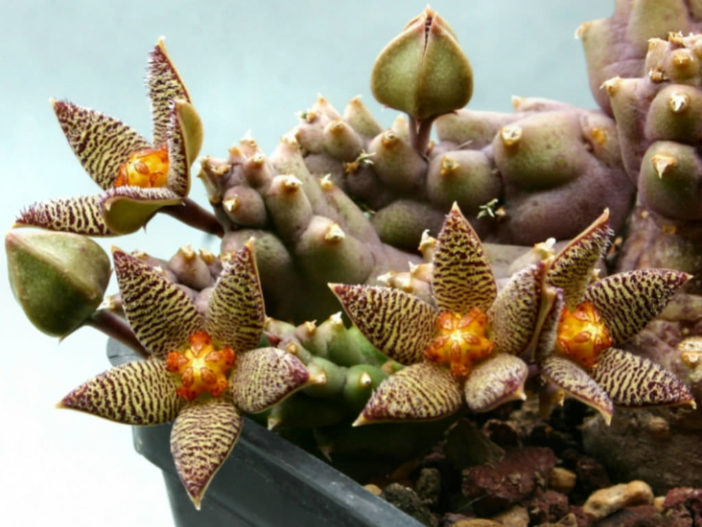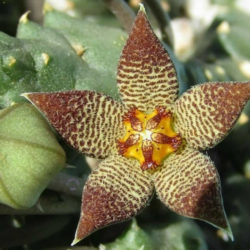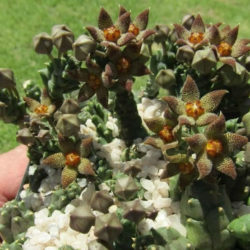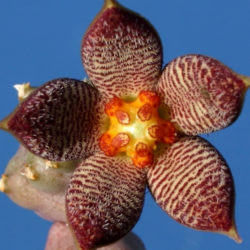Scientific Name
Piaranthus geminatus var. foetidus (N.E. Br.) Meve
Accepted Scientific Name
Piaranthus geminatus (Masson) N.E. Br.
Synonym(s)
Piaranthus foetidus
Scientific Classification
Family: Apocynaceae
Subfamily: Asclepiadoideae
Tribe: Ceropegieae
Subtribe: Stapeliinae
Genus: Piaranthus
Description
Piaranthus geminatus var. foetidus, also known as Piaranthus foetidus, is a dwarf, mat-forming succulent with 4- to 5-angled, gray-green stems with small tubercles with apical deltoid leaf-rudiment. The stems can grow up to 6 inches (125 cm) long and 1 inch (2.5 cm) thick.
Flowers are star-shaped, up to 1.2 inches (3 cm) in diameter, and appear in the upper part of the stems in fall. The outside of the corolla is smooth, green or green with a purplish hue, while the inside is finely hairy, yellow with short transverse purplish-crimson lines and spots. The tips of the lobes are sometimes almost entirely purplish-crimson. The corona is yellow to orange.
Origin
Piaranthus geminatus var. foetidus is native to South Africa (Eastern Cape and Western Cape). It is not accepted as a variety and is listed as a form of Piaranthus geminatus.

Hardiness
USDA hardiness zone 10a to 11b: from 30 °F (−1.1 °C) to 50 °F (+10 °C).
How to Grow and Care
Stapeliads are relatively easy to grow. However, they should be treated as outdoor plants as they will easily rot indoors and cannot flower without exposure to outdoor temperature fluctuations. They should be grown under cover so that watering can be controlled. They require a reasonable amount of sunlight to promote flowering and maintain a well-shaped plant. Very shady positions will produce very poor flowering. Stapeliads come from climates where they survive too high temperatures in the summer months, so most growth is in spring and autumn, with flowering in autumn when the weather starts to cool down.
The easiest and best way to propagate Stapeliads is from stem cuttings, which can be taken virtually throughout the year. Using the seed is also a method of propagation. They all need extra good drainage. Stapeliads are shallow-rooted, and their collection can be planted nicely in a wide, shallow bowl. When planting, it is a good idea to allow the roots to be buried in soil and then put pure gravel or sand around the plant's base to prevent rot.
See more at How to Grow and Care for Stapeliads.
Links
- Back to genus Piaranthus
- Succupedia: Browse succulents by Scientific Name, Common Name, Genus, Family, USDA Hardiness Zone, Origin, or cacti by Genus
Photo Gallery
Click on a photo to see a larger version.


